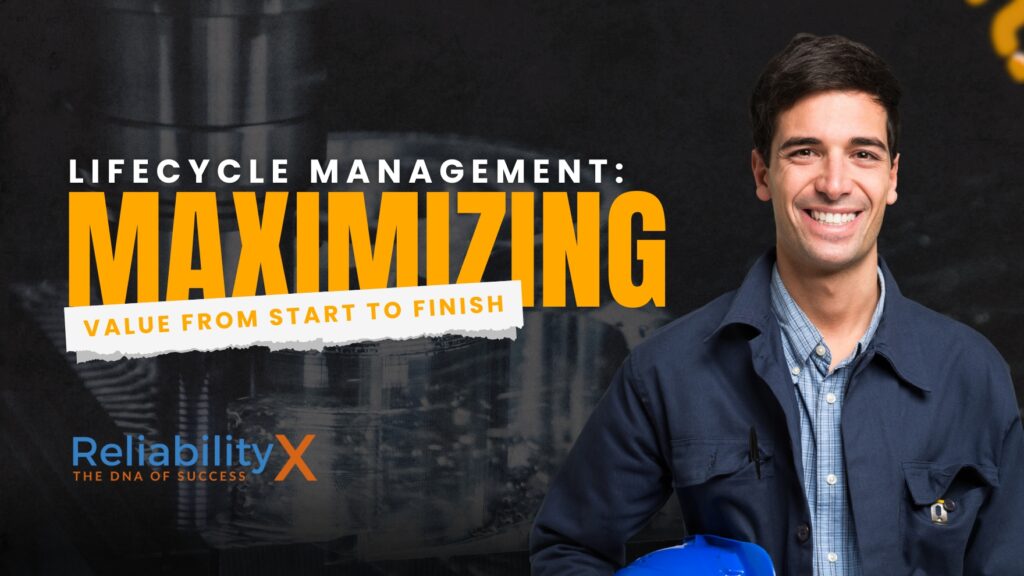Lifecycle Management in Asset Management
By: Joe Anderson
Lifecycle Management in Asset Management: Maximizing Value from Start to Finish
Asset-intensive industries rely on effective lifecycle management to optimize performance, reduce costs, and extend asset longevity. Lifecycle management in asset management is a strategic approach that ensures assets deliver maximum value from acquisition to decommissioning.
By understanding and managing each phase of an asset’s lifecycle, organizations can make informed decisions, reduce unplanned downtime, and improve return on investment (ROI). A structured lifecycle management approach helps businesses align their assets with operational, financial, and sustainability goals.
What is Asset Lifecycle Management?
Asset Lifecycle Management (ALM) is the process of managing assets systematically from planning and acquisition to operation, maintenance, and eventual disposal. The goal is to optimize costs, reliability, and performance throughout the asset’s entire lifespan.
The five key phases of asset lifecycle management are:
- Planning and Acquisition
- Commissioning and Deployment
- Operation and Maintenance
- Performance Optimization
- Decommissioning and Disposal
Each stage requires a different approach to maximize asset value and minimize risks.
Why is Lifecycle Management Important?
1. Reduces Total Cost of Ownership (TCO)
- Many organizations focus on the initial purchase price of an asset, but the real cost is spread across its entire lifecycle. Effective ALM:
- Minimizes unnecessary capital expenses by selecting the right assets.
- Reduces maintenance and repair costs through proactive strategies.
- Optimizes asset utilization, extending service life.
2. Enhances Reliability and Performance
- A well-managed asset lifecycle ensures:
- Higher uptime and operational efficiency.
- Fewer unexpected failures that disrupt production.
- Increased return on investment (ROI) through extended asset lifespan.
3. Supports Sustainability and Compliance
- Proper lifecycle management aligns with environmental and regulatory requirements by:
- Ensuring assets are operated efficiently to reduce waste.
- Implementing sustainable disposal and recycling practices.
- Complying with ISO 55000 asset management standards and industry regulations.
4. Improves Decision-Making with Data-Driven Insights
- With modern technology like IoT sensors, predictive analytics, and digital twins, organizations can make data-driven decisions to:
- Predict failures before they happen.
- Optimize maintenance schedules.
- Justify capital investments with accurate lifecycle cost analysis.
Key Phases of Asset Lifecycle Management
1. Planning and Acquisition
This phase determines what assets are needed, how they will be used, and what costs are involved. Critical activities include:
- Defining asset requirements based on operational needs.
- Evaluating procurement options to balance cost, quality, and longevity.
- Assessing total cost of ownership (TCO) rather than just purchase price.
2. Commissioning and Deployment
Once acquired, assets must be properly installed, tested, and integrated into operations. This stage includes:
- Conducting initial inspections and reliability testing.
- Setting up asset tracking and monitoring systems.
- Training personnel on correct operation and maintenance procedures.
3. Operation and Maintenance
This is the longest phase of an asset’s life, where reliability and efficiency matter most. Key practices include:
- Preventive and predictive maintenance to extend asset life.
- Condition monitoring using IoT and AI to detect early failure signs.
- Root cause analysis (RCA) to prevent recurring failures.
4. Performance Optimization
Continuous improvement ensures assets operate at peak performance through:
- Asset performance reviews and benchmarking.
- Upgrades and modifications to enhance efficiency.
- Reliability-centered maintenance (RCM) to refine maintenance strategies.
5. Decommissioning and Disposal
At the end of its useful life, an asset must be disposed of responsibly. This involves:
- Evaluating whether to refurbish, repurpose, or replace the asset.
- Sustainable disposal practices (recycling, resale, or scrapping).
- Capturing lessons learned to improve future asset purchases.
Best Practices for Effective Lifecycle Management
1. Implement a Digital Asset Management System
A Computerized Maintenance Management System (CMMS) or Enterprise Asset Management (EAM) software helps track asset performance, maintenance history, and costs throughout the lifecycle.
2. Use Predictive Maintenance Technologies
Leveraging IoT sensors, AI, and machine learning helps detect failures early and optimize maintenance efforts.
3. Adopt a Risk-Based Approach
- Prioritize asset maintenance and replacement based on:
- Asset criticality (impact on operations).
- Failure probability and consequences.
- Cost-benefit analysis of upgrades vs. replacements.
4. Foster a Lifecycle-Centric Culture
- Educate teams on the importance of proactive asset management to:
- Encourage ownership and accountability for asset performance.
- Align maintenance, operations, and finance teams for better decision-making.
- Promote a long-term, data-driven mindset in asset management.
Conclusion
Asset Lifecycle Management (ALM) is essential for maximizing asset performance, reliability, and cost efficiency. By managing each phase strategically—from acquisition to decommissioning—organizations can reduce downtime, optimize costs, and improve long-term sustainability.
With advancements in digital technologies, predictive maintenance, and risk-based strategies, businesses that embrace lifecycle management gain a competitive edge by ensuring assets operate at peak efficiency for as long as possible.
Ready to take control of your asset performance? Start with a free consultation from ReliabilityX. We’ll help you assess your current lifecycle strategy and identify opportunities to reduce costs, boost reliability, and align with your operational goals. Book your free consult now.
